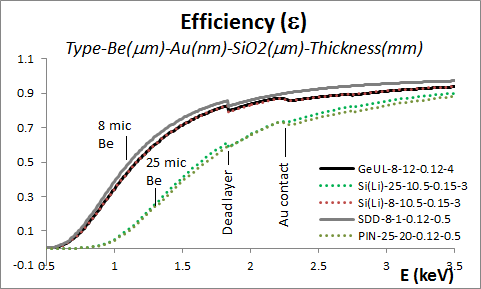3.2.1 Efficiency
The efficiency of a detector is a measure of the probability that an incident photon will be producing a response in the detector. It is usually quoted as the ratio of recorded counts to the original incoming flux of radiation. Absolute efficiency εabs is composed by the detector intrinsic efficiency ε (number of recorded events to the number of photons impinging in the detector) and the effective solid angle of detection G (fraction of photons or particles that reach the detector to the total number of radiation emitted by the source). The latter depends on the overall solid angle representing the fraction of emitted photons from the sample that reach the detector material.

The detector intrinsic efficiency ε(E) varies with the energy of the incident radiation, as illustrated in the figure below for the case of semiconductor detectors.

At large energies the probability of travelling through the detector volume without producing an interaction increases with the decrease of the detector thickness and the efficiency drops.

At low energies, efficiency drops due to the attenuation of the radiation in the detector entrance window (usually from Be), the front metal contact layer (Au) and the crystal surface dead layer.